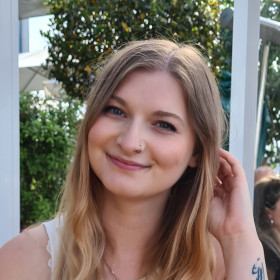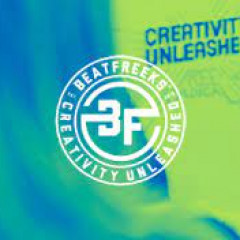Firstly, Amerah Saleh introduced Beatfreaks and their history before showcasing Antonio's art inspired by the insights collected from last years data collection.
Beatfreeks was founded in 2013 by Anisa Morridadi who wanted to create change in data collection and distribution. She wanted to highlight the issues important to young people and support them in creating change. What started as a rented out coffee shop and an invite to young people as a test to see if anyone was interested in coming to express their views and share their art turned into a weekly poetry jam every Thursday in Birmingham through high demand and eventually turned into Beatfreeks organisation. Beatfreeks has worked with over 50,0000 creatives to connect them to brands and funders so they can share their experiences and views about the world. This has allowed the participating organisations to stay relevant in the world and gain new insight but has also helped the young people to gain skills and contacts for their futures.
Fabio Thomas then introduced National Youth Trends:
Which is Beatfreeks’ channel to showcase young people (aged 15-25), youth voice and pop culture in the UK. This includes the thoughts and opinions of young people, a statistics game and the opportunity to benefit your organisation through the research based insights provided. This is all in an attempt to make the world better suited to national youth trends. This is done by collecting data from young people in creative ways, such as using different art forms and trends. This encourages more young people to participate and share their views and help make a difference. This data is then analysed and a report is produced however, the reports are not like the traditional reports most will be used to. They are filled with the art and creativity used by young people to express their views. Therefore, diversifying the collection of data - reimagining what it looks like to collect, read and interpret data.
We were then introduced to Antonio Roberts:
The artist who has been working with National Youth Trends recently to create a series of digital artworks based on the insights gained from data collected in 2020 from nearly 2,000 young people across the UK. Antonio then introduced his work ‘Pop Up’ as it is inspired by pop up adverts and cookies which collect our data and have become a norm in our everyday internet experience. The digital art uses emoji balloons to express the abstract ideas found in the data. Antonio states that he used emojis as they cross generational and age boundaries. Many different age groups use emojis everyday and for a multitude of reasons. Therefore they are one aspect of using the internet that connects us all. In the art work it is noted that the emoji balloons’ height represents the amount the view or opinion was mentioned within the data: the higher the balloon the more it was found in the research. Antonio stated that this also allowed the data to be shown in more of a creative, human way which more people can relate to. Antonio also noted that this project was an eye opener for him into the views of young people and how data can be collected and distributed in many different ways.
After this we viewed the art work we then heard from a panel of individuals who work within companies who also use art to collect or showcase data and research. Each individual answered one question and spoke about their experiences in creative data collection and distribution. On the panel was Hannah Redler-Hawes who works at the Open Data Institute, who works with companies and governments to build an open and trustworthy ecosystem. Their ‘Our Data as Culture’ programme exhibits and commissions artworks, engaging diverse audiences with artists and worlds that use data as art material (https://culture.theodi.org/about/). There was also Tom Cahill-Jones who is the partnership manager for Creative Industries Policy and Evidence Centre (PEC) led by Nesta, who describe themselves as the innovation foundation and involves a UK-wide consortium of universities (https://pec.ac.uk/). Finally, Antonio was also on the panel as he has worked with many companies and organisations in this sector and has been a creative for over 10 years primarily working with video and coding in his art. He hopes working technology into art will make it more accessible and approachable for everyone, so society can have a say in how it is used in the future.
Overall this launch Zoom was really eye opening to someone who hasn’t heard a lot about creative data collection and distribution. It was really interesting to hear about different organisations and how they collect and distribute data and also who they show the data to in order to create positive change within society. It was also interesting to hear each individual's experiences within the arts and data sector, discussing the changes they’ve seen and hope to see in the future.
To read more click on this link: https://beatfreeksyouthtrends.com/reads/creativity-digital-art-and-data-interview-with-antonio-roberts/









0 Comments